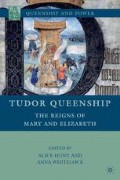Abstract
Some time ago I came across the following entry posted on the Questions and Answers section of a popular Tudor History website:
I visited Westminster Abbey several years ago and was absolutely astounded at the placement of the tomb of Elizabeth I … compared to where and how the tomb of Mary Stuart was placed!! {I}t seems that James gave his mother’s tomb more precedence than Elizabeth’s, who placed him on the throne. And why were Elizabeth and Mary {Tudor} placed in the same tomb when they disliked each other? It seems like a joke played on them by James. The docet at the Abbey couldn’t give me an answer … 1
Access this chapter
Tax calculation will be finalised at checkout
Purchases are for personal use only
Preview
Unable to display preview. Download preview PDF.
Notes
Julia M. Walker, “Reading the Tombs of Elizabeth I,” ELR, 26 (1996): 510–30.
Phillip Lindley, “ ‘The singular mediacion and praiers of all the holie companie of Heven’: Sculptural Functions and Forms in Henry VII’s Chapel” in Westminster Abbey: The Lady Chapel of Henry VII, ed. Tim Tatton-Brown and Richard Mortimer (Woodbridge: Boydell, 2003), 259–94; 273.
A. P. Stanley, Historical Memorials of Westminster Abbey, 2 vols. (New York, 1882), Appendix: Account of the Search for the Grave of King James I, 367–403.
Jennifer Woodward, The Theatre of Death: The Ritual Management of Royal Funerals in Renaissance England, 1570–1625 (Woodbridge: Boydell, 1997), 73.
Jennifer Woodward, The Theatre of Death, ch. 4, 67–86; 85. See also Antonia Fraser, Mary Queen of Scots (London: Weidenfeld & Nicolson, 1969), 546–9.
Letter to the Dean and Chapter of Peterborough Cathedral; Dated August 28, 1612; see Nigel Llewellyn, “The Royal Body: Monuments to the Dead, for the Living” in Renaissance Bodies: The Human Figure in English Culture c. 1540–1660, ed. Lucy Gent and Nigel Llewellyn (London: Reaktion, 1990), 218–40; 227–8.
Alice Strickland, Lives of the Queens of Scotland and English Princesses Connected with the Regal Succession of Great Britain, 8 vols. (Edinburgh: William Blackwood and Sons, 1851), II: 445.
For Darnley’s status see William S. Daniel, History of the Abbey and Palace of Holyrood (Edinburgh: D. Anderson, 1852), 67.
See John Watkins, Representing Elizabeth in Stuart England: Literature, History, Sovereignty (Cambridge: Cambridge University Press, 2002), esp. ch. I, “James I and the Fictions of Elizabeth’s Motherhood,” 14–35.
Privy Purse Expenses of the Princess Mary, Daughter of King Henry the Eighth, Afterwards Queen Mary, ed. F. Madden (London: William Pickering, 1831), clxxxvii.
John Strype, Annals of the Reformation and Establishment of Religion, and Other Various Occurrences in the Church of England, During Queen Elizabeth’s Happy Reign, 4 vols, in 7 parts (Oxford: Clarendon Press, 1824) v.I.i: 400.
Peter Sherlock, “The Monuments of Elizabeth Tudor and Mary Stuart: King James and the Manipulation of Memory,”Journal of British Studies 46 (2007): 263–89; 274.
Two proclamations forbidding tomb desecration were issued, in 1560 and 1571. See David Howarth, Images of Rule: Art and Politics in the English Renaissance, 1485–1649) (Basingstoke: Palgrave Macmillan, 1997), 154.
John Strype, Ecclesiastical Memorials Relating Chiefly to Religion and the Reformation of It, 3 vols. (London, 1721), III, 597, quoted in Jennifer Woodward, Theatre of Death, 57. See also David E. Stannard, The Puritan Way of Death: A Study in Religion, Culture and Social Change (Oxford: Oxford University Press, 1979), 101–2.
For this, and for Mary’s “hyper-sensitivity” to any hint of her illegitimacy, see E. W Ives, “Tudor Dynastic Problems Revisited,” Historical Research 81 (2008): 255–79.
Anne McLaren, “Political Ideas” in Susan Doran and Norman Jones (eds.) The Elizabethan World (London: Routledge, 2010).
Anne McLaren, “Monogamy, Polygamy and the True State: James I’s Rhetoric of Empire,” History of Political Thought, 25 (2004): 446–80; 453–4.
Mark Nicholls, A History of the Modern British Isles, 1529–1603: The Two Kingdoms (London: Wiley-Blackwell, 1998), 145.
For an excellent treatment of Anglo-French relations and Mary of Guise’s regency, see Pamela E. Ritchie, Mary of Guise in Scotland, 1548–1560: A Political Career (East Linton: Tuckwell Press, 2002).
Patrick Collinson, “Puritans, Men of Business and Elizabethan Parliaments,” Parliamentary History 7 (1988): 187–211.
Anne McLaren, “The Quest for a King: Gender, Marriage and Succession in Elizabethan England,” Journal of British Studies 41 (2002): 259–90.
James Emerson Phillips, Images of a Queen: Mary Stuart in Sixteenth-Century Literature (Berkeley: University of California Press, 1964).
Michael A. R. Graves, Thomas Norton: The Parliament Man (Oxford: Blackwell, 1994), ix.
Graham Hough, The First Commentary on “The Faerie Queene” (privately printed, 1964), 8.
CSPVen, IX: 1592–1603, 531–48; 540. James’s fears that he would be denied the English crown on one or the other ground were long-standing. See D. H. Willson, King James VI and I (London: Jonathan Cape, 1958), 139–41.
Correspondence of King James VI of Scotland with Sir Robert Cecil and Others in England, During the Reign of Queen Elizabeth, ed. John Bruce (London: Camden Society, 1861), 61–2.
For the resulting ambiguities, see D. R. Woolf, “Two Elizabeths? James I and the Late Queen’s Famous Memory,” Canadian Journal of History 20 (1985) 167–9.
James I, Basilikon Doron or His Majesties Instrvctions to His Dearest Sonne, Henry the Prince (Edinburgh, 1599),
Political Works of James I, ed. Charles Howard McIlwain (Cambridge, MA: Harvard University Press, 1918), 3–52; 35.
See W B. Patterson, King James VI and I and the Reunion of Christendom (Cambridge: Cambridge University Press, 2000).
Editor information
Editors and Affiliations
Copyright information
© 2010 Anna Whitelock and Alice Hunt
About this chapter
Cite this chapter
McLaren, A. (2010). Memorializing Mary and Elizabeth. In: Hunt, A., Whitelock, A. (eds) Tudor Queenship. Queenship and Power. Palgrave Macmillan, New York. https://doi.org/10.1057/9780230111950_2
Download citation
DOI: https://doi.org/10.1057/9780230111950_2
Publisher Name: Palgrave Macmillan, New York
Print ISBN: 978-1-349-38093-0
Online ISBN: 978-0-230-11195-0
eBook Packages: Palgrave History CollectionHistory (R0)

